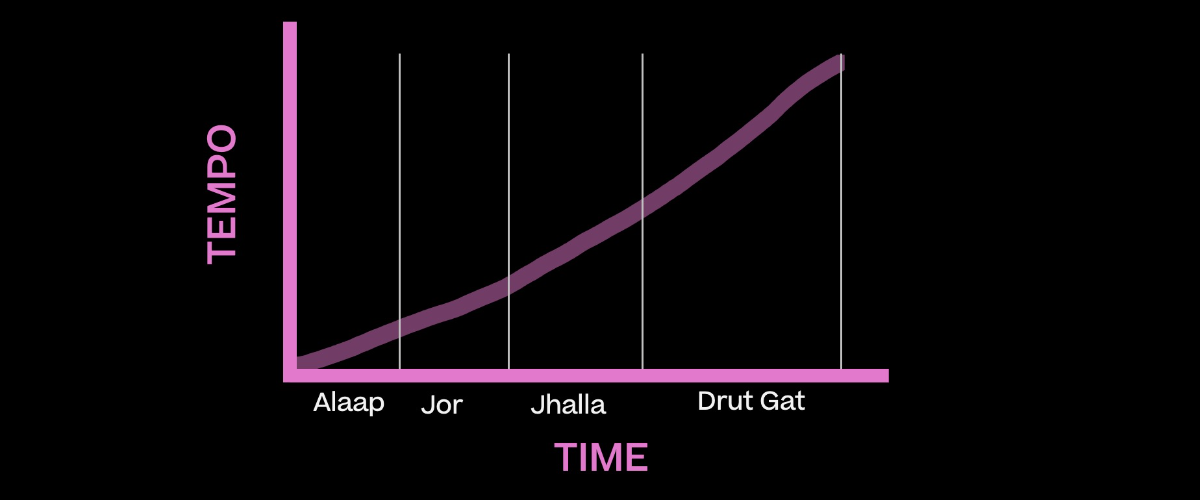

A vocal performance of classical Indian music is ranked higher than a purely instrumental one (see 'the pecking order'). Nowadays, it is more usual to have performances of khayal, as opposed to the older, purer form of dhrupad. For khayal, there is usually just one soloist (often a maestro of some standing, male or female), sometimes supported by a senior or advanced student who is granted the privilege of also playing the accompanying tanpura to provide a constant drone in the background.
Other accompanying instruments are the tabla for percussion and some kind of melodic instrument, ideally a sarangi although but it is more usual to find a harmonium for melodic accompaniment. The role of the melodic instrument is purely a secondary one, mainly shadowing and filling in some interludes if the singer requires to pause, or to briefly think through the next improvisation since khayal, although based on a composed song text, is a highly ornamented improvised form of singing.
The melodic instrument player is typically seated to the left of the singer whilst the percussionist sits on the right. The tanpura player usually sits just a little behind the vocalist.
Currently, particularly on international concert stages, there is a requirement for the audience to be able to see all the accompanying musicians whereas traditionally, in the old days in India, accompanists, particularly tanpura players, were almost hidden behind the soloist whilst accompanying musicians generally went unacknowledged and often uncredited on recordings.
The singer begins with a short alap (slow, pulse-free introduction) exploring the chosen raag (melodic structure) and its main characteristics. This section is usually sung without words and once the raag has been established, the main song text composition begins, in a very slow tempo known as vilambit. The song text is minimal in khayal and mostly acts as a refrain for the extensive improvisation that is required by this form of singing. The words are designed to usually match the general mood of the raag.
After this section, the singer will launch into a second composition in the same raag but usually a different taal (rhythm cycle) and the tempo is generally increased for the second piece. From raag exploration in the first piece, which concentrates on the notes of the raag, the focus now shifts to numerous technical flourishes and the rendition of complex taans (melodic passages) and ornamentation known as gamak.
Depending on the performer’s mood and audience reaction, there could be a third, even faster short composition in the same raag, or the singer could move on to an entirely different raag, again delivered in the same format as the first one.
On average concerts last between two and two-and-a-half hours, so it is now more usual for the singer to move on to something entirely different from a lighter classical repertoire, usually a thumri or bhajan. For these shorter and lighter pieces, the emphasis is more on delivering the song text in an appropriate manner rather than a full exploration of the raag.
Listen to the music | Kaushiki Chakraborty sings the romantic afternoon Raag Bhimpalasi, showcasing the ornaments and rapid-fire taans of her Patiala gharana. Live from Darbar Festival 2015.
Jameela Siddiqi is an author, linguist, and BBC cultural commentator, specialising in postcolonial fiction and the devotional music of South Asia.
Darbar believes in the power of Indian classical music to stir, thrill, and inspire. Explore our YouTube channel, or subscribe to the Darbar Concert Hall to watch extended festival performances, talk and documentaries in pristine HD and UHD quality.
The Jaipur-Atrauli vocalist talks ragas from the past, rhythms as warrior-heroes, and the limits of approaching music...
Read More 
VR360 Festival | Darbar brings Indian classical music into the realm of virtual reality. We see VR as a way of...
Read More 
The sarod is a plucked string instrument, now as popular and predominant in North Indian classical music as the sitar.
Read More 
The beginner's guide to Indian classical music. Whether you’re completely new to raga music or just need a refresher, we’ve put together this brief overview of all things raga music to help you feel at ease when visiting one of our concerts or watch our videos on our YouTube or our Darbar Concert Hall.

Keep up to date with the latest news, events, music and musings across our social channels
For hundreds more clips and shorts, vist our YT page here 
Be the first to hear before events go on sale. Get the latest news and articles from Darbar